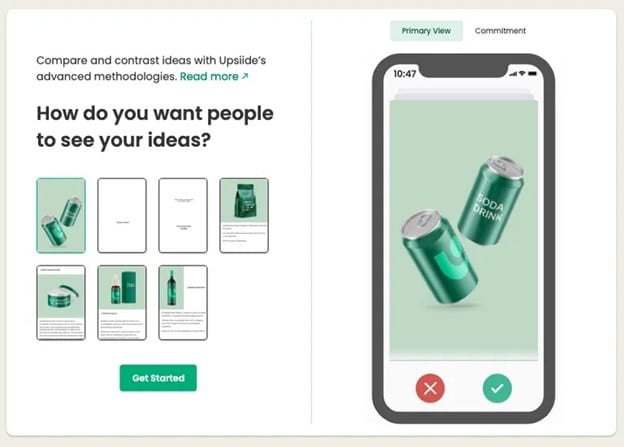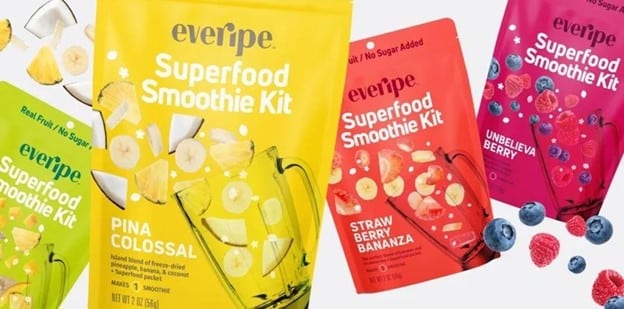Your definitive guide to doing concept testing the modern way. Discover what concept testing is, how it has evolved and the best practices for conducting concept testing surveys (with examples!).

Determining which concept or idea has the best chance of success requires skill. To understand what your consumers will buy, consider their needs, wants and challenges.
And we all know that if a person likes a particular element in your product or design, they are more likely to choose you over the competition. So, if you want to improve the performance of your ideas, you should start assessing them in advance. That’s why you should understand the art of concept testing.
What is concept testing?
Concept testing (also known as concept validation) is a process of assessing and evaluating ideas before they are introduced to the public.
Whether you’re at the early product development stage or want to rejig your existing product concept for a specific target audience, concept testing is your best way to accurately predict your new idea’s performance in-market.
As a marketing or insights professional, you can use concept testing to predict the success of your idea. Testing your concepts in advance helps you reduce the risk of losing money in case of failure and improves your chances of standing out from the competition.
Why concept testing needs to be part of your innovation research
1. You’ll save money
Testing the validity of your new concepts will save you money and make you more money because you’re minimizing risk and optimizing for success when the concept comes to life.
2. You’ll find the most optimal idea
The purpose of concept testing is to help you eliminate ideas that might not work in-market. It’s a great tool to gain an objective view of your concept(s) and will help your team choose the best possible direction. Plus, it will also allow you to identify the ideas that might need further improvement. This way, you won’t have to discard most of your concepts but simply optimize them for the future.
3. You’ll develop proof points
Persuading team members and key stakeholders of the potential of your product innovation becomes easier when your concept validation metrics quantify that exact potential.
4. You’ll build confidence
Concept validation will get rid of the guesswork and give you the confidence to choose ideas with a better product-market fit.
How to test concepts in a modern way
Online and mobile experience
Consumer behaviour has always changed with the times, and we think the concept testing process should start adjusting to those changes.
The emergence of mobile technologies way back when is one of the factors that has impacted people’s habits and priorities the most. They’ve become more technologically savvy and became pretty attached to their phones. We think this is where concept testing is still playing catch-up.
While we’ve fixed the traditional model that meant research required high budgets, longer execution times and a whole heap of people and resources, many agile research platforms and consultancies still force respondents or customers to answer questions in ways that make giving honest and considered answers challenging. They’re still leveraging survey methods that aren’t in sync with the way that people use their phones and engage with brands.
Our platform is essentially a statement towards more mobile-friendly survey platforms. Our idea screening methodology takes inspiration from how people utilize phones today and leverages the swiping action to emulate how we use social media.

Agile concept testing
Going back to that convo about testing concepts iteratively, we believe in the power of agile concept testing.
The agile movement comes from the software development world. It starts with gathering consumer feedback as early as possible by releasing a minimally viable product (MVP). So, agile means iteratively adapting or improving your concept based on consumer feedback.
The reality is that your concept may not be as easy to update as software! That’s why in many industries (including market research), being agile means leveraging market research to test ideas early and iteratively optimize them before launch.
We discovered that when it comes to agility, a 3-step approach in which you prioritize, optimize and validate concepts leads to the best results. If you want to learn more about the agile process and what those 3 steps mean, this video is your best resource.
Best practices for doing a concept test
1. Engage key stakeholders in the process
This practice is often overlooked by brands, and this leads to quite a few problems further down the line. Say, for example, a product manager decided to test new product concepts but didn’t think to involve the brand’s salespeople, customer service team or marketers in the process.
This oversight might create problems from the start: the product manager might not be aware of the most pressing customer issues and end up coming up with product ideas that don’t solve those issues. And this might then lead to useless results, internal miscommunications and a less-than-ideal final product. Upsiide’s hot tip: we always recommend that our clients bring their key decision-makers and team members into the process right from the beginning. Having these subject matter experts share their experiences and harness their knowledge will power internal brainstorming sessions.
Not only will you have new concepts that align with customer needs, but you’ll also have a happy team that is aligned toward a common goal.
2. Keep the respondent experience in mind
When writing concept testing surveys, it’s crucial to bear one thing in mind – keep your surveys simple.
Don’t use sophisticated sentences or special jargon – this might confuse respondents and affect their willingness to complete the survey. Ask your questions in the same way you’d ask them if you were speaking to a friend or colleague. That way, people like your potential customers will find it easier to answer questions and give the responses you’re searching for.
Speaking of simplicity, try to be specific about the scope of your survey so that it isn’t too long. One of the worst things you can do is to throw in questions “just in case you might need them”, because the more questions you add, the higher the chance that people will drop off or give you unconsidered responses.
Upsiide’s hot tip: we recommend that surveys shouldn’t take longer than 5-10 minutes, and questions should be concise. This will make the respondents’ experience a good one and ensure they’re giving thoughtful answers and accurate data.
3. Explore different ways of presenting ideas and concepts
Since people are looking for fun and engaging survey experiences, choosing a format that supports this kind of experience will help you increase the quality of your findings. And modern survey-making technologies can help you with that because they offer a variety of formats to test concepts. But the best platforms offer flexibility in the way you showcase your ideas.
If you want to assess a new package design, you’ll, of course, need to show respondents an image to react to. But being able to get creative about the way that image shows up for the respondent, whether or not they can zoom in or out to examine it, and which extra information appears alongside the packaging image is when things get interesting.

Upsiide’s hot tip: If you’re evaluating several ideas in one test, we suggest sticking to one format per test. So, don’t present one product concept in a video and another in a photo. This decision might negatively impact the test results.
Psst! Want to get started on your concept test but need some pointers? We have this handy article that explains how to write a concept well.
4. Just because a concept doesn’t perform well immediately doesn’t mean it isn’t worth further exploration
The beauty of concept testing is that it’s always an opportunity to learn and refine. Once you finish the concept evaluation process and identify your top-performing ideas, go back to the results and look at the ideas that didn’t do well. Think: is there a reason they didn’t perform as well? What would you change to make them more appealing? Are there any more innovative ideas you want to add to the test? Take a dig through the different demographic breakdowns; is there a specific subset of your respondents that the idea did do well with?
If you have answers to the questions above, consider tweaking your concepts a bit to test them again. You can then compare the results. Who knows, maybe you’ll get a better sense of your target market demographic, get some great actionable insights about a single concept, or even learn more about why your top-performing ideas were so popular.
Upsiide’s top tip and a short story: ADVANCED, a producer of energy supplements, found great use in iterative testing. When they wanted to find the best packaging design for their new RTD product, they did 3 tests with Upsiide to get a sense of a creative direction, fine-tune the best ideas and see how they stand against giants like Monster and Red Bull. Even though this example is related to pack design testing, we think it shows the value of testing ideas several times. If ADVANCED’s team hadn’t performed tests iteratively, they wouldn’t have been able to regroup, re-align, and optimize for the things they really needed to find out.
How Everipe used Upsiide’s Concept Testing tool to grow the business with certainty
Everipe, a brand that produces healthy superfood smoothie kits, wanted to understand the market potential of a new product line.
Kerry Roberts, the co-founder of Everipe, describes the dilemma:
“We were constantly working with the manufacturer and iterating on the product, and we were struggling to bridge that gap between the product, the wider vision, and the anecdotal feedback we’d get from people that sampled the product.”
That’s where Upsiide came in.

Kerry leveraged Upsiide to benchmark Everipe’s as-yet unlaunched product line against the dominant competitors in the category.
Our team used Upsiide’s swiping methodology to understand consumers’ interest and commitment to the Everipe proposition, as compared with the propositions of their key competitors. We then ran a study that dove deep into the Everipe brand and product portfolio to understand how consumers felt about the brand and packaging – again – as compared with their competition.
The results were not only surprising but game-changing for their business.
“The thing that is most beautiful to me about concept testing on Upsiide is that the forced choice methodology doesn’t just tell you whether consumers like or dislike a concept; it simulates real-world decision-making.
I know how dependable the data is that comes from a ‘forced choice’ study experience. If you’re working with a limited insights budget, this methodology means you won’t have to trade off on the integrity or sophistication of a larger quant survey.”
Kerry Roberts, Founder, Everipe


